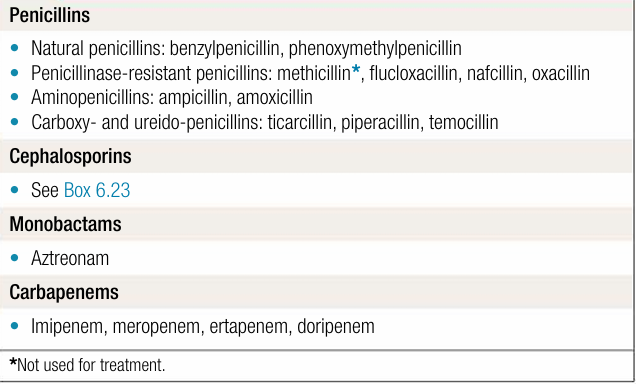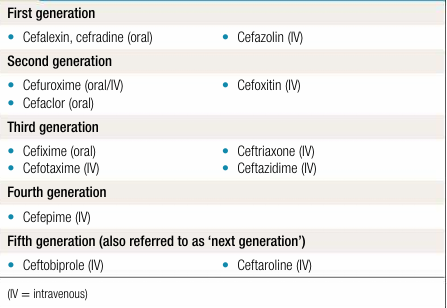
β-lactam antibiotics
 المؤلف:
Stuart H. Ralston , Ian D Penman, Mark W J Strachan , Richard Hobson
المؤلف:
Stuart H. Ralston , Ian D Penman, Mark W J Strachan , Richard Hobson
 المصدر:
Davidsons Principles and Practice of Medicine
المصدر:
Davidsons Principles and Practice of Medicine
 الجزء والصفحة:
24th Edition , p117-118
الجزء والصفحة:
24th Edition , p117-118
 2025-01-27
2025-01-27
 906
906
These antibiotics have a β-lactam ring structure and exert a bactericidal action by inhibiting PBPs and cell wall synthesis. (They are classified in Box1) Pharmacokinetics
- Good drug levels are achieved in lung, kidney, bone, muscle and liver, and in pleural, synovial, pericardial and peritoneal fluids.
- CSF levels are low, except when meninges are inflamed. ‘Inoculum effect’: the activity of ß-lactams is reduced in the presence of a high organism burden, although the clinical relevance of this effect is a subject of debate.
- Generally safe in pregnancy (except imipenem/cilastatin).

Box1. β-lactam antibiotics
Adverse effects Immediate (IgE-mediated) allergic reactions are rare but life-threatening. Approximately 90% of patients who report a penicillin allergy do not have a true IgE-mediated allergy, highlighting the importance of careful allergy histories and documentation of reactions. Other reactions, such as rashes, fever and haematological effects (e.g. low white cell count), usually follow more prolonged therapy (more than 2 weeks). Patients with infectious mononucleosis may develop a rash if given aminopenicillins; this does not imply lasting allergy. The relationship between allergy to penicillin and allergy to cephalosporins depends on the specific cephalosporin used. Avoidance of cephalosporins, however, is recommended in patients who have IgE-mediated penicillin allergy . Cross-reactivity between penicillin and carbapenems is rare (approximately 1% by skin testing) and carbapenems may be administered if there are no suitable alternatives and appropriate resuscitation facilities are available.
Gastrointestinal upset and diarrhoea are common, and a mild reversible hepatitis is recognised with many β-lactams. More severe forms of hepatitis can be observed with flucloxacillin and co-amoxiclav. Leucopenia, thrombocytopenia, coagulation deficiencies, interstitial nephritis and potentiation of aminoglycoside-mediated kidney damage are also recognized. Seizures and encephalopathy have been reported, particularly with high doses in the presence of renal insufficiency. Thrombophlebitis occurs in up to 5% of patients receiving parenteral β-lactams.
Drug interactions Synergism occurs in combination with aminoglycosides in vitro. Ampicillin decreases the biological effect of oral contraceptives and the whole class is significantly affected by concurrent administration of probenecid, producing a 2–4-fold increase in the peak serum concentration.
Penicillins
Natural penicillins are primarily effective against Gram-positive organ isms (except staphylococci, most of which produce a penicillinase) and anaerobic organisms. Streptococcus pyogenes has remained sensitive to natural penicillins worldwide. According to the European Antimicrobial Resistance Surveillance Network (EARS-Net), the prevalence of non-sus- ceptibility to penicillin in Streptococcus pneumoniae in Europe in 2018 varied widely from 0.1% (Belgium) to 40% (Romania).
Penicillinase-resistant penicillins are the mainstay of treatment for infections with Staph. aureus, other than MRSA. However, EARS-Net data from 2018 indicate that MRSA rates in Europe vary widely from 0% (Iceland) to 43% (Romania).
Aminopenicillins have the same spectrum of activity as the natural penicillins, with additional Gram-negative cover against Enterobacterales. Amoxicillin has better oral absorption than ampicillin. Unfortunately, resistance to these agents is widespread (Escherichia coli Europe-wide in 2018, range 35.3%–67.6%), so they are no longer appropriate for empiric use in Gram-negative infections. In many organisms, resistance is due to β-lactamase production, which can be overcome by the addition of β-lactamase inhibitors (clavulanic acid or sulbactam).
Carboxypenicillins (e.g. ticarcillin) and ureidopenicillins (e.g. piperacillin) are particularly active against Gram-negative organisms, especialy Pseudomonas spp., which are resistant to the aminopenicillins. ß-lactamase inhibitors may be added to extend their spectrum of activity (e.g. piperacillin tazobactam). Temocillin is derived from ticarcillin; it has good activity against Enterobacterales, including those that produce ESBL enzymes, but poor activity against P. aeruginosa and Gram-positive bacteria.
Cephalosporins and cephamycins
Cephalosporins are broad-spectrum agents. Unfortunately, their use is associated with C. difficile infection. With the exception of ceftobiprole, the group has no activity against enterococci. Only the cephamycins have anti-anaerobic activity. All cephalosporins are inactivated by ESBL. Cephalosporins are arranged in ‘generations’ (Box 2).

Box2. Cephalosporins
- First-generation compounds have excellent activity against Gram positive organisms and some activity against Gram-negatives.
- Second-generation drugs retain Gram-positive activity but have extended Gram-negative activity. Cephamycins (e.g. cefoxitin), included in this group, are active against anaerobic Gram negative bacilli.
- Third-generation agents have improved anti-Gram-negative cover age. For some (e.g. ceftazidime), this is extended to include Pseudomonas spp. Cefotaxime and ceftriaxone have excellent Gram-negative activity and retain good activity against Strep. pneumoniae and β-haemolytic streptococci. Ceftriaxone is administered once daily and is therefore a suitable agent for outpatient intravenous (parenteral) antimicrobial therapy (OPAT).
- Fourth-generation agents, e.g. cefepime, have a broad spectrum of activity, including streptococci and some Gram-negatives, including P. aeruginosa .
- Fifth-generation agents, such as ceftobiprole and ceftaroline, have an enhanced spectrum of Gram-positive activity that includes MRSA, and also have activity against Gram-negative bacteria; some, such as ceftobiprole, are active against P. aeruginosa .
- Cefiderocol is a novel siderophore cephalosporin, which is also active in the presence of ESBLs and carbapenamases.
The spectrum of cephalosporins has also been enhanced by adding β-lactamase inhibitors, e.g. ceftazidime/avibactam and ceftolazone/ tazobactam.
Monobactams
Aztreonam is the only available monobactam. It is active against Gram negative bacteria, except ESBL-producing organisms, but inactive against Gram-positive organisms or anaerobes. It is a parenteral-only agent and may be used safely in most penicillin-allergic patients other than those with an allergy to ceftazidime, which shares a common side chain.
Carbapenems
These intravenous agents have the broadest antibiotic activity of the β-lactam antibiotics, covering most clinically significant bacteria, including anaerobes (e.g. imipenem, meropenem, ertapenem). Carbapenems are also being combined with β-lactamase inhibitors in response to emergence of carbapenemase enzymes that inactivate this class (e.g. meropenem-vaborbactam).
 الاكثر قراءة في مواضيع عامة في المضادات الميكروبية
الاكثر قراءة في مواضيع عامة في المضادات الميكروبية
 اخر الاخبار
اخر الاخبار
اخبار العتبة العباسية المقدسة


